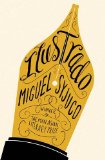
Winner of the 2008 Man Asian Literary Prize
Illustrado begins with the discovery of an author’s body in the Hudson river. The victim was about to publish a controversial novel exposing the corruption present in the Philippines and although the New York Police are convinced that there is no foul play, others suspect that he was murdered. The novel’s narrator, Miguel Syjuco (yes, he is named after the author!) was being mentored by the victim at the time of his death. He heads to the Philippines to try to discover the truth, writing a biography of his teacher in order to gain as much information about the man as possible.
The premise of the novel is quite basic, but the structure is complex and often difficult to understand. The book contains extracts from the fictitious controversial novel, blog posts, newspaper clippings and weird dream sequences. I can’t fault the writing quality, but there were many times when I couldn’t see the relevance of the passage I was reading and was confused about what was happening.
Regular readers of this blog will know that I have struggled with blog posts in books before, unfortunately Illustrado is not an exception to this rule. Perhaps I’m just behind the times, but I found all the blog posts, especially the comments, very irritating. The book also contained annoying sections from emails and texts:
His Nokia tring-trings. Our forlorn protagonist sits up in bed and fumbles in the darkness. He looks at the bright screen of the cell phone. It’s a text message from his old pal Markus: Welcm bak, bro! Old skool tunes all week @ Club Coup d’Etat. Our crew will be there, with Charlie. My treat. DJ Supermodeldiva spinning phat beats. When the screen dims, the hotel room seems to get smaller.
Illustrado is clearly pushing the boundaries in novel writing, but there were many points when I thought it over-stepped the mark – being too clever/innovative for its own good. The passages may be an accurate reflection of modern life, but I often found myself cringing as I read them.
The book reminded me of 2666 by Roberto Bolaño in that both books benefit from being studied – requiring multiple re-readings to really understand what is happening and a study guide to pick up on all the subtle references. Unfortunately I didn’t have the benefit of a study guide or an informed reading partner and so I felt as though I missed out on much of the book’s depth. I recommend reading this book with several other people in the hope that you will all spot different things, as I imagine you’d have a long wait for the study guide!
I’m afraid that I was too irritated by this book to consider re-reading it, but I think it is an important book and some people will love uncovering its many literary layers.
The Picador website has some wonderful interviews with Miguel Syjuco and further information about the book.
